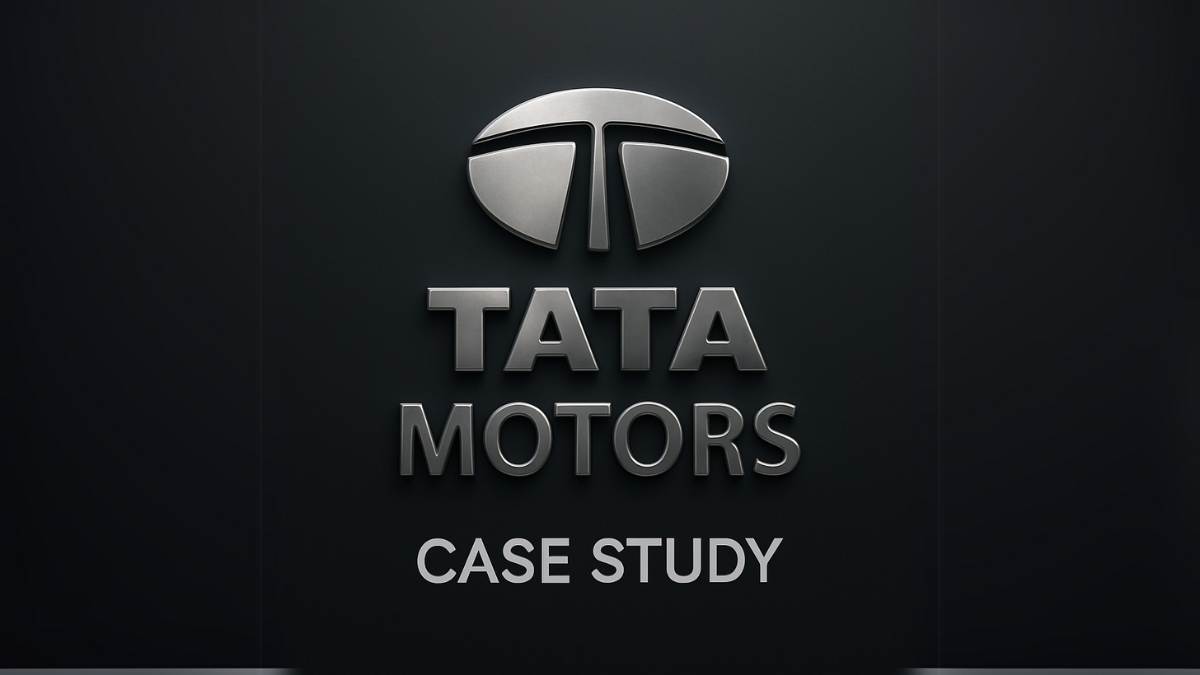Tata Motors is a name almost every Indian knows. You’ve probably seen their cars, buses, or trucks on the road, or maybe you’ve even owned one. But there’s a lot more to this company than just making vehicles.
Table of Contents
It’s a brand that took bold steps when others were playing it safe. They launched India’s first home-made car. They made the world’s cheapest car. They even bought a luxury car company from the UK when the global economy was struggling.
So why is Tata Motors worth studying?
Because it’s full of lessons. Whether you’re a student, a business owner, a marketer, or someone building a startup, you’ll find something useful in how Tata Motors grew, adapted, and kept moving forward even during tough times.
In this Tata Motors Case Study, we’ll look at how the company started and what shaped its journey, how they build and sell their vehicles, how they’re thinking about electric cars, and the future, and what we can all learn from their wins and mistakes
Let’s start at the beginning.
Tata Motors: Origin, Evolution & Vision
Tata Motors started way back in 1945. At the time, it was called TELCO, which stood for Tata Engineering and Locomotive Company. Their main job back then was to make trucks and trains, not cars.
For many years, they focused on heavy vehicles, especially for businesses and the government. But in the 1990s, things started to change. That’s when Tata Motors entered the passenger car market.
The big shift happened under the leadership of Mr. Ratan Tata. He believed India should have its own car, one that was designed and built entirely in the country. This idea led to the launch of the Tata Indica in 1998. It was India’s first car developed from scratch by an Indian company. It wasn’t perfect, but it was a proud moment.
After that, Tata Motors kept moving forward. In 2008, they made headlines when they bought Jaguar Land Rover (JLR) from Ford. People thought it was a risky move, a struggling Indian company buying a luxury British brand? But that decision later turned out to be a game-changer.
What drives Tata Motors?
The company says its mission is to build vehicles that excite people and make their lives better. Over the years, their focus has expanded, now they care not just about cars, but also about sustainability, electric mobility, and making India a leader in the global auto industry.
In short, Tata Motors went from making trucks to leading India’s auto transformation, and they’re not done yet.
Also Read: Digital Marketing Training in Panchkula
Business Model & Revenue Streams
Tata Motors operates a diversified business model spanning domestic and international markets. In FY24, it reported revenue of ₹4,37,928 crore and a net profit of ₹31,807 crore. Here’s how it makes money:
- Domestic vs. International: India remains its core market, but Tata Motors operates in over 125 countries with 8,800 touchpoints. JLR alone accounts for almost 69% of consolidated revenue, driven by premium vehicles sold globally. (Source)
- B2C and B2B Segments: Passenger vehicles (cars, SUVs, EVs) cater to individual buyers, while commercial vehicles (trucks, buses) serve businesses and government contracts. The ACE EV, a small commercial EV, is a recent B2B hit.
- Manufacturing, Design, and R&D: Tata Motors runs 10 manufacturing facilities in India and 12 global JLR plants. Its R&D centers in India, the UK, and South Korea focus on engine efficiency, safety, and EV tech. In FY24, R&D spending surged 45% to ₹29,398 crore. (Source)
- Revenue Breakdown: Passenger vehicles (Tiago, Nexon, etc.), commercial vehicles, EVs, spare parts, and services like financing and rentals contribute. JLR’s luxury sales are the biggest cash cow.
This mix stabilizes income and reduces reliance on any single market or segment.
Also Read: Uniqlo Case Study
Product Portfolio & Key Innovations
Tata Motors’ product range is vast and versatile:
- Passenger Cars: Models like Tiago, Nexon, Harrier, and Safari target families, youth, and urban buyers. The Nexon and Altroz earned five-star Global NCAP safety ratings, a rare feat for Indian cars.
- Commercial Vehicles: Tata leads India’s truck and bus market with models like the ACE and Super Milo, known for fuel efficiency.
- Tata Nano: Launched in 2008 as the world’s cheapest car ($2,500), it aimed to bring mobility to India’s masses. It flopped due to poor marketing and quality perceptions but remains iconic.
- Electric Vehicles: Tata dominates India’s EV market, led by the Nexon EV and Tigor EV. The Tiago EV and XPRES-T EV cater to budget and fleet buyers.
- Concept Cars: The electric Jaguar I-Pace won three World Car Awards in 2019, showcasing Tata’s futuristic vision.
Innovations like bio-methane bus engines and connected car tech highlight Tata’s R&D muscle.
Also Read: Amul Case Study
Marketing & Branding Strategy
Tata Motors’ branding has evolved from “reliable but basic” to aspirational. Its “Connecting Aspirations” campaign captures this shift, emphasizing innovation and emotional connection.
- Local vs. Global: In India, Tata targets everyone from rural buyers (Nano, ACE) to urban millennials (Nexon). Globally, JLR markets luxury to high-net-worth buyers.
- Target Segments: Tata serves low-income families, young professionals, and businesses. JLR targets affluent buyers seeking prestige.
- Digital Push: SEO, social media, and influencer campaigns amplify reach. Partnerships with celebrities and digital platforms boost visibility.
- Safety and Sustainability: Tata highlights crash-test ratings and its EV leadership to build trust.
This multi-pronged approach keeps Tata relevant across diverse markets.

Enroll Now: Advanced Digital Marketing Course
Global Presence & Market Expansion
Tata Motors operates in over 175 countries, from the UK to South Africa. JLR’s premium vehicles dominate in Europe and North America, while Tata’s commercial vehicles thrive in Asia and Africa. In 2023, Tata overtook Hyundai in India’s market share, hitting 14.85%. (Source)
- EV Exports: Tata plans to sell EVs globally, leveraging India’s cost-competitive manufacturing.
- Emerging Markets: Asia and Africa’s growing middle classes are prime targets. Tata tailors products like the Punch SUV to local needs.
- Future Roadmap: Expansion hinges on EVs and JLR’s global network, with plans to enter new markets by 2030.
Tata’s global push balances scale with localization, a lesson for any brand eyeing international growth.
Also Read: Netflix Case Study
Tata Motors vs Competitors: Peer Analysis
Tata Motors faces fierce competition but holds its own:
- Maruti Suzuki: Dominates India with 50% passenger vehicle share but lags in EVs.
- Hyundai: Strong in design and technology, Hyundai held a 13.8% market share in 2023, making it the second-largest carmaker in India at that time. However, by April 2025, its share had declined to 12.47%, placing it fourth in the rankings.
- Mahindra & Mahindra: A key EV rival, Mahindra & Mahindra held a 16% market share in India’s EV segment as of January 2025, trailing Tata Motors. (Source)
- Toyota, Skoda: Global giants compete in premium segments but lack Tata’s EV focus in India.
Differentiators: Tata’s safety focus (five-star NCAP ratings), EV dominance, and JLR’s luxury edge set it apart. Its affordable yet innovative designs appeal to India’s price-sensitive market.
Also Read: Starbucks Case Study
SWOT Analysis of Tata Motors
Here’s a deep dive into Tata Motors’ strengths, weaknesses, opportunities, and threats, based on industry insights:
- Strengths:
- Diversified Portfolio: From Nano to JLR, Tata serves every segment.
- JLR’s Global Reach: Contributes 69% of revenue and premium tech.
- R&D Investment: 45% YoY increase in FY24 fuels innovation.
- Brand Trust: Tata’s century-old legacy and safety focus win loyalty.
- Weaknesses:
- Profit Volatility: JLR’s early losses and chip shortages hurt margins.
- Heavy Debt: Net auto debt is improving but remains a concern.
- Quality Perceptions: Past criticism for inconsistent quality lingers.
- Opportunities:
- EV Revolution: India’s electric vehicle (EV) market is projected to grow at a compound annual growth rate (CAGR) of 25.3% from 2025 to 2032, presenting significant growth potential for Tata Motors. (Source)
- Global SUV Demand: Models like Nexon and Harrier can tap emerging markets.
- Digital Transformation: AI and big data can optimize manufacturing and customer service.
- Threats:
- Intense Competition: Maruti, Hyundai, and Mahindra innovate rapidly.
- Global Recession Risk: Economic slowdowns could cut vehicle demand.
- Regulatory Shifts: Stricter emissions norms raise production costs.
This SWOT reveals Tata’s strong foundation but highlights the need to address debt and competition.
Also Read: Coca-Cola Case Study
Challenges & Turning Points
Tata Motors has faced its share of storms:
- Post-Acquisition Struggles: After acquiring JLR, Tata Motors grappled with debt and operational difficulties, testing its financial stability.
- Leadership Resolve: Under Ratan Tata’s guidance, the company implemented bold restructuring and efficiency measures to steer through the crisis.
- Global Disruptions: Events like Brexit and semiconductor shortages posed major hurdles, especially for JLR’s production and sales.
- Strategic Resilience: Tata Motors adapted by reworking supply chains, focusing on high-demand models, and maintaining brand strength.
- Return to Stability: Despite external pressures, the company regained momentum, restoring confidence in its long-term vision and execution.
These pivots show Tata’s resilience, a blueprint for navigating crises.
Also Read: McDonald’s Case Study
Conclusion: What Can We Learn from Tata Motors?
Tata Motors’ journey, from locomotives to global EV leadership, offers rich lessons. Its ability to balance affordability (Nano) with premium offerings (JLR) shows the power of a diversified portfolio. Strategic acquisitions like JLR and bold bets on EVs highlight the importance of long-term vision. Despite challenges like debt and competition, Tata’s focus on R&D, safety, and sustainability keeps it relevant.
Takeaways:
- Marketers: Blend emotional branding (“Connecting Aspirations”) with digital strategies for impact.
- Product Managers: Prioritize safety and innovation to differentiate in crowded markets.
- Startup Founders: Build resilience through diversification and ecosystem partnerships.
Tata Motors proves that with grit, innovation, and adaptability, a local brand can compete globally. What’s your key takeaway from their story?
Also Read: Amul Case Study
FAQs: Tata Motors Case Study
1. Can Tata Motors become a global leader in the automotive industry?
With JLR’s luxury reach, a strong EV portfolio, and operations in 175 countries, Tata has the potential. However, it must overcome debt and compete with giants like Toyota and Tesla.
2. Why is electric mobility a key focus for Tata Motors?
EVs align with global sustainability trends and India’s EV policies. Tata’s 86% market share in India’s EV sector in 2023 shows its early-mover advantage.
3. What are Tata Motors’ latest innovations in EV and automotive tech?
Tata’s Ziptron platform, bio-methane bus engines, and connected car tech lead the pack. The electric Jaguar I-Pace won three World Car Awards in 2019.
4. Which company made the world’s cheapest car, and why did it fail?
Tata Motors launched the Tata Nano in 2008. It failed due to poor marketing (branded as “cheap” rather than affordable) and quality concerns.
5. Is Tata Motors still focused on budget-friendly cars in 2025?
Yes, with models like Tiago and Punch, but it’s also scaling up EVs and premium SUVs to diversify.
6. How does Tata Motors align with the Tata Group’s overall ecosystem?
Tata Motors leverages Tata Power for EV charging, Tata Elxsi for software, and Tata Chemicals for batteries, creating a robust EV ecosystem.

